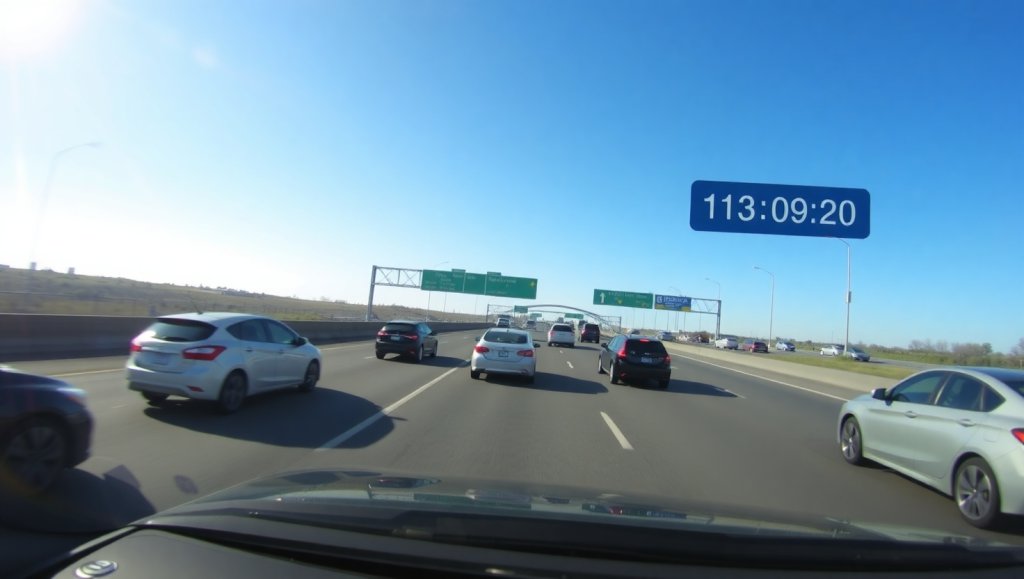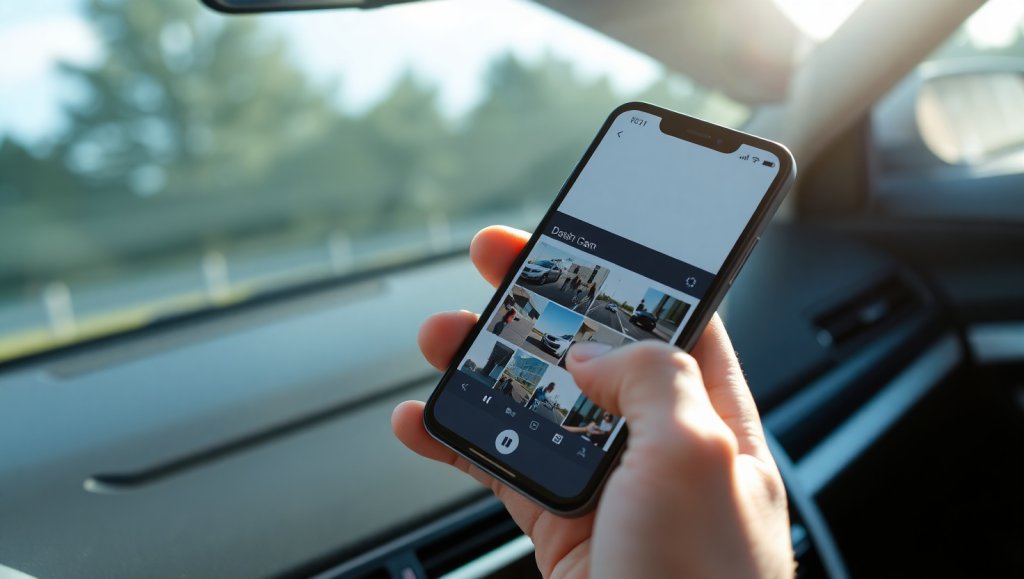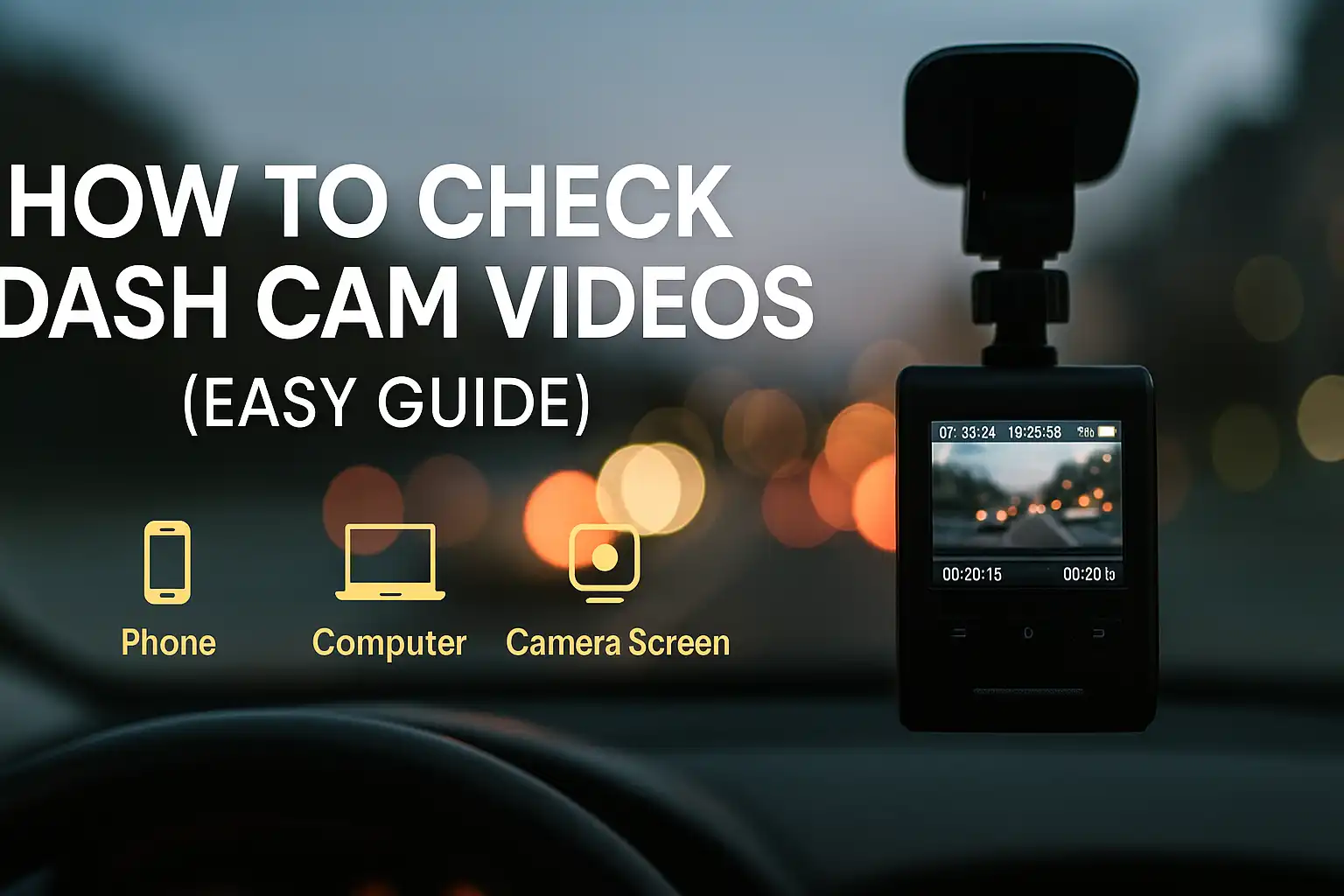Checking dash cam videos is simple. Use your phone with the app, remove the microSD card and view on a computer, or review clips on the camera screen. Follow these steps to access, save, and share the footage you need.
But how do you access those crucial videos? You might be wondering if it’s a complicated process, or if you need special equipment. Rest assured, checking videos from your dash cam can be simple and straightforward. In this guide, you’ll discover exactly how to retrieve and view your dash cam footage effortlessly.
Whether it’s for reliving a memorable drive or ensuring peace of mind after an incident, knowing how to access your dash cam videos can be incredibly empowering. Ready to unlock the full potential of your dash cam? Let’s dive in and make sure you never miss a detail.

Choosing The Right Dash Cam
Accessing videos from your car’s dash cam is easy. Connect the device to your computer using a USB cable. Alternatively, insert the memory card into a card reader. Use video playback software to view the recordings.
Choosing the right dash cam can make a big difference. It helps in capturing important moments while driving. Not all dash cams offer the same features. Some provide better video quality. Others offer unique functionalities. Picking the right one needs careful thought.
Features To Consider
Consider video resolution. Higher resolution means clearer videos. Check for night vision capability. This ensures good video quality in low light. Look for a wide-angle lens. It captures more of the road. GPS tracking is helpful. It records your location and speed. Loop recording saves space. It records over old footage when storage is full.
Types Of Dash Cams
There are single-lens dash cams. They record the front view. Dual-lens dash cams capture both front and rear views. Some dash cams are wired. Others are wireless and need battery charging. There are dash cams with screens. These allow for immediate video review. Some models upload footage to the cloud. Ensure the type suits your needs.

Installing Dash Cam Software
Installing dash cam software is a straightforward yet vital step in accessing the videos recorded by your car’s dash cam. The right software not only allows you to view your footage but also helps in organizing and storing videos efficiently. Whether you’re tech-savvy or new to the world of dash cams, understanding the installation process can significantly enhance your experience.
Compatible Devices
First, ensure your device is compatible with the dash cam software. Most dash cams work seamlessly with both Windows and macOS. You can often use your smartphone or tablet too, making it easy to check footage on the go. However, compatibility can vary depending on your dash cam model. Check the manufacturer’s specifications for a list of supported devices. If you’re unsure, reach out to their customer support for guidance.
Have you ever tried accessing your dash cam footage only to realize your device isn’t supported? It’s a common hurdle that can be avoided with a bit of pre-check. Make sure your device meets the minimum requirements before proceeding.
Downloading Necessary Apps
Once you’ve confirmed compatibility, the next step is downloading the necessary apps or software. Most dash cams come with a dedicated app available on app stores like Google Play or the Apple App Store. Simply search for the app using the dash cam’s brand name. Typically, these apps are free and offer a user-friendly interface.
Downloading the app is as simple as tapping a button, but have you considered the benefits of additional features these apps might offer? Some apps provide cloud storage options and real-time streaming, enhancing your dash cam experience. Dive into the app’s features and see which ones align with your needs.
Have you ever wondered how you can maximize the use of your dash cam? By installing the right software, you unlock a world of possibilities beyond just viewing footage. You gain access to video editing tools, easy sharing options, and more. What’s the most exciting feature you look forward to using?
Accessing Dash Cam Videos
Your car’s dash cam is not just a set-and-forget device. It’s a treasure trove of information and memories waiting to be accessed. Whether you’re checking footage from a recent road trip or reviewing an unexpected incident, accessing your dash cam videos is simpler than you might think. Let’s explore the different ways you can get to those important recordings.
Using A Smartphone
Most modern dash cams offer the convenience of connecting to your smartphone. This means you can view videos on-the-go, without needing to remove the memory card. Many dash cams come with an app that you can easily download on your phone. Have you ever found yourself stuck in traffic, curious about what happened earlier on your drive? Open the app, connect via Wi-Fi, and browse through the footage right from your car seat.
Ensure your dash cam’s Wi-Fi is enabled. Once connected, you can not only view but also download and share videos directly from your phone. This method is perfect for quick access when you’re away from home.
Connecting To A Computer
For those who prefer a larger screen, connecting your dash cam to a computer is the way to go. Simply remove the memory card from your dash cam and insert it into your computer. Use a card reader if necessary.
Once inserted, open the folder to view your videos. This method is ideal for long-term storage and detailed analysis. Imagine capturing a beautiful sunset on a long drive, and now you want to keep that memory forever. Simply save the video to your computer’s hard drive.
Via The Dash Cam Screen
Some dash cams come equipped with their own screens, allowing you to watch videos directly on the device. While the screen might be small, it’s incredibly handy for instant playback. Have you ever wondered if your parking was captured correctly? You can check it immediately without any additional devices.
Navigate through the dash cam’s menu to find the playback option. This method is excellent for quick checks, ensuring you’ve captured what you need before leaving your vehicle.
Each method of accessing your dash cam videos offers its own advantages. Which one suits your lifestyle best? Consider how often you need to view your footage and the tools you have at your disposal. By understanding these options, you’ll always be prepared to review your recordings when the need arises.
Reviewing Footage
Checking dash cam videos is simple. Connect the camera to your computer using a USB cable, or remove the memory card and use a card reader. Open the video files on your device to review your footage.
Reviewing footage from your car’s dash cam is crucial. It helps you verify incidents and ensure safety. This process can provide insights into driving habits. It also offers evidence in case of accidents. Knowing how to review this footage is essential. It keeps you informed and prepared.
Playing Back Videos
To view videos, first, remove the memory card. Insert it into a card reader connected to your computer. Open the files using a media player. Most modern dash cams save videos in common formats like MP4. Ensure your media player supports these formats. Some dash cams also offer smartphone apps. These apps enable wireless video access. This feature is convenient and quick.
Key Moments To Focus On
While reviewing, pay attention to critical moments. Look for sudden stops or unusual movements. Observe any instances of harsh braking. This might indicate potential incidents. Check interactions with other vehicles. Watch for close encounters or lane changes. Also, review footage around the time of known incidents. This helps in understanding the context better.
Managing Video Files
Managing video files from your car’s dash cam can seem challenging. But with a few steps, it becomes easy. You need to know how to save, organize, and delete files. These actions help keep your recordings neat and accessible. Let’s explore how you can manage your dash cam videos effectively.
Saving Important Clips
Dash cams record continuously, but not all footage is necessary. Save important clips immediately after an incident. Most dash cams have a button to lock files. This prevents them from being overwritten. Alternatively, you can transfer files to a computer or cloud storage. Regularly check saved clips to ensure they are intact.
Organizing And Deleting Files
Organizing files makes future access easier. Create folders based on dates or events. Label them clearly for quick identification. Regularly review and delete unnecessary files. This frees up space for new recordings. Use dash cam software for batch deleting. It saves time and effort. Keep your dash cam’s storage clean and well-organized.
Troubleshooting Common Issues
Dash cams provide valuable evidence during road incidents. They record everything on the road. But, sometimes you may face issues with playback. This section will guide you through common problems. Learn how to troubleshoot these issues effectively.
No Video Playback
Your dash cam might not play videos. First, check the memory card. Ensure it’s correctly inserted into the device. You might need to format it. Formatting can resolve playback issues. Make sure your dash cam supports the video format. Older models might not support newer formats. Update the firmware if necessary. This can improve compatibility and fix playback issues.
Corrupted Files
Corrupted files can be frustrating. They won’t open or play correctly. This usually happens due to improper shutdowns. Never remove the memory card when the dash cam is on. This can damage the files. Use reliable software to recover corrupted files. Often, file recovery tools can restore them. Regularly back up your videos. This ensures you won’t lose important footage.
Device Connectivity Problems
Dash cams need proper connectivity. They often connect via USB or Wi-Fi. Check the cable if using USB. Make sure it’s not damaged. A faulty cable can hinder connectivity. For Wi-Fi issues, ensure both devices are on the same network. Restart both devices if necessary. This can resolve temporary connectivity glitches. Keeping your device firmware updated can also help. Regular updates improve connectivity performance.
Tips For Optimal Use
Having a dash cam in your car is a smart choice. It provides security and peace of mind. But to get the best results, you need to know how to use it effectively. This section will guide you on optimal use of your dash cam. Follow these tips to ensure your dash cam works perfectly.
Regular Software Updates
Ensure your dash cam software is up-to-date. This enhances performance and adds new features. Check for updates regularly on the manufacturer’s website. Some dash cams have an app for easy updates. Always follow the instructions for updating. It prevents bugs and improves video quality.
Maintaining Storage Space
Dash cams record high-quality video. This can quickly fill up storage space. Regularly check your storage to avoid running out of space. Delete unnecessary footage. Save important videos to an external device. Use a memory card with high storage capacity. This ensures you always have space for new recordings.
Frequently Asked Questions
How do I view dash cam recordings on a computer?
Remove microSD, use a card reader, open MP4 files, and back up important clips.
How do I access footage on my phone?
Turn on the camera’s Wi-Fi, connect in the app, browse and download.
What if files won’t play?
Reformat the card in-camera (after backing up), update firmware, try a different player, and avoid removing the card while the cam is writing.
Conclusion
Checking your dash cam videos is simple and quick. Connect your dash cam to a computer. Use the USB cable provided. Open the dash cam folder and locate the videos. Play them using any media player. This process helps in reviewing incidents.
You can also save important clips on your computer. Keep your dash cam manual handy for troubleshooting. Regularly check and clear old videos. This ensures your dash cam has enough storage. With these steps, you efficiently manage your dash cam footage.
Stay safe and informed on the road.


